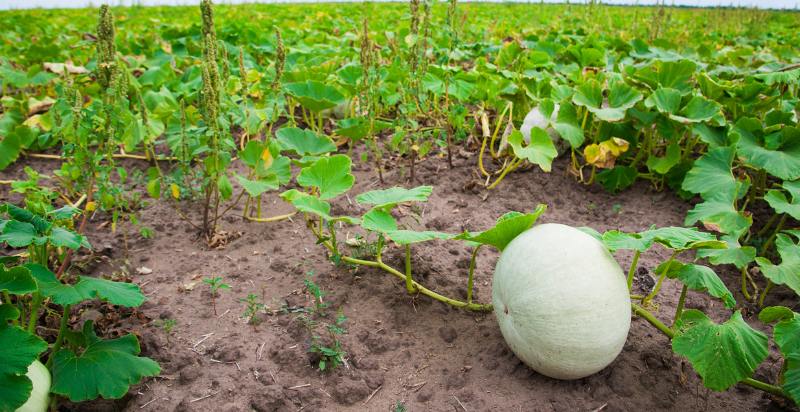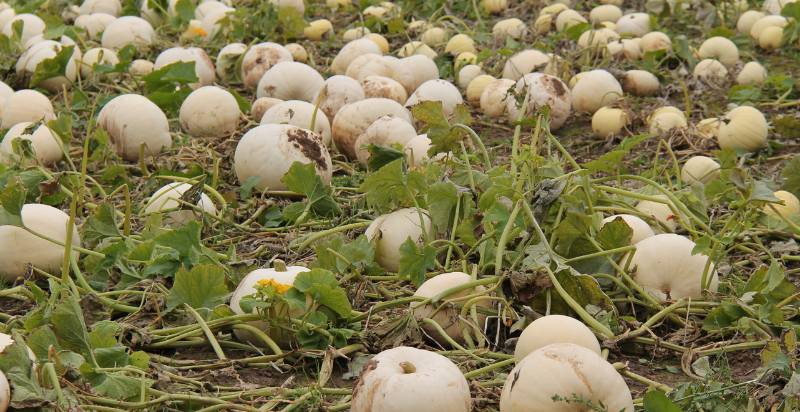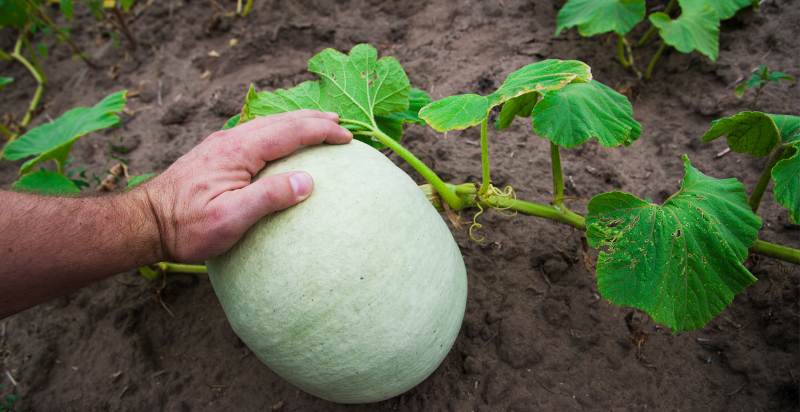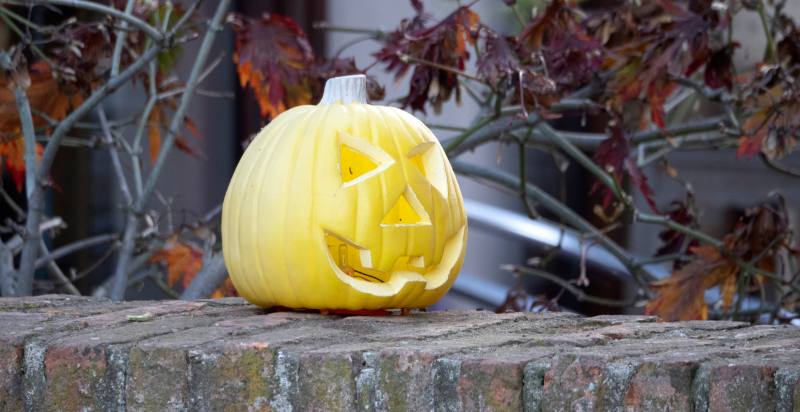Pumpkins come in all shapes, sizes, and colors. While most people think of the traditional orange pumpkin when they think of this gourd, white pumpkins are becoming increasingly popular. These unique fruits can be used for decoration or carving and make a great addition to any fall décor.
If you’re interested in growing white pumpkins, read on for everything you need to know about planting, caring for, and harvesting these spooky fruits.
What Are White Pumpkins?
White pumpkins are a variety of winter squash that belongs to the Cucurbita family. This family also includes other popular squashes like zucchini and acorn squash. White pumpkins get their name from their pale white skin. The flesh of white pumpkins is also white or pale yellow.
These fruits are sometimes called “ghost pumpkins” or “Lumina pumpkins” and are popular for their unique appearance. White pumpkins range from small, like a softball, to large, like a watermelon. The average weight of a white pumpkin is between 6 and 10 pounds.
History Of White Pumpkins:
Pumpkins have been grown in North America for thousands of years. Native Americans were growing pumpkins long before the arrival of Europeans. Pumpkin seeds have even been found in archeological sites that date back over 5,500 years.
While pumpkins come in many different colors, including white, orange, green, and blue, the traditional orange pumpkin is thought to have originated in North America. Orange pumpkins were first brought to Europe by early settlers and then spread to other parts of the world from there.
White pumpkins are less common than their orange cousins but are gaining popularity, especially in recent years. These were first grown in North America but are now cultivated worldwide.
Name origin
The white pumpkin gets its name from its pale white skin. The flesh of white pumpkins is also white or pale yellow. These fruits are sometimes called “ghost pumpkins” or “Lumina pumpkins” and are popular for their unique appearance.
White Pumpkins Description:
White pumpkins are a variety of winter squash that belongs to the Cucurbita family. This family also includes other popular squashes like zucchini and acorn squash. These ranges from small, like a softball, to large, like a watermelon. The average weight of a white pumpkin is between 6 and 10 pounds.
The skin of white pumpkins is thin and delicate. This makes them more difficult to carve than traditional orange pumpkins. However, the skin’s smoothness can make white pumpkins ideal for painting or decorating.
Its flesh is dense and creamy. It has a sweet flavor with notes of nutmeg and cinnamon. White pumpkin flesh can be used in sweet or savory dishes. It can also be roasted, pureed, or made into soup.

What Are The Health Benefits Of White Pumpkins?
Pumpkins are a good source of fiber, vitamins, and minerals. They contain a lot of water and a few calories and fat. Beta-carotene, an antioxidant that the body converts to vitamin A, is another important component of pumpkins. Vitamin A benefits the immune system, cell growth, and vision.
In addition to being a healthy food, white pumpkin pulp has traditionally been used as a natural remedy for digestive problems like diarrhea and constipation. The flesh of white pumpkins can also be applied topically to soothe inflammation and skin irritation.
Cultivation:
White pumpkins are grown in the same way as other varieties of squash. They are usually started from seed in late spring or early summer. The seeds need to be planted in moist, well-drained soil and receive lots of light.
It require a long growing season and must be planted at least 2 months before the first frost date. They should be ready to harvest in 90-100 days.
When the fruits are ripe, they will have a dull white color, and their skin will be hard to the touch. It can be harvested by hand or with a sharp knife. They should be stored in a cool, dry place and will keep for several months.
Growing White Pumpkins:
If you’re interested in growing white pumpkins, you’re in luck. These fruits are relatively easy to grow and don’t require much special care. Read everything you need to know about planting, caring for, and harvesting it.
Planting
It should be planted in early summer after the last frost has passed. They can be started from seed or transplanted from a nursery.
If you’re starting from seed, sow the seeds indoors about six weeks before the last frost date. Plant the seeds in peat pots filled with sterile potting mix. Keep the soil moist but not wet, and place the pots in a warm, sunny location. When the seedlings are 4-6 inches tall, they can be transplanted outdoors.
If you’re transplanting from a nursery, choose healthy, disease-free plants. Transplant the seedlings into prepared garden beds after all danger of frost has passed. Space the plants 24-36 inches apart.

Care
White pumpkins require full sun and well-drained soil to grow properly. Before planting, amend the soil with compost or other organic material to increase fertility and drainage.
Water white pumpkins regularly, providing about an inch of water per week. Avoid getting water on the leaves to prevent fungal diseases. Mulch around the plants to help retain moisture and control weeds.
Fertilize white pumpkin plants every two weeks with a balanced fertilizer during the growing season. Stop fertilizing about a month before harvest.

Pests and diseases
White pumpkins are relatively resistant to pests and diseases but can be susceptible to powdery mildew, cucumber beetles, and squash bugs.
Powdery mildew is a fungal disease that causes white, powdery spots on the leaves of pumpkin plants. The disease can spread quickly and can weaken or kill the plant. To prevent powdery mildew, water the plants at ground level and avoid getting water on the leaves. Remove infected leaves from the plant.
Cucumber beetles are small, striped insects that feed on the leaves and fruits of pumpkin plants. The beetles can transmit bacterial wilt, a serious disease that can kill pumpkin plants. Cover the plants with insect-proof netting or row covers to prevent cucumber beetles. Remove and destroy any beetles that you find on the plants.
Squash bugs are large, dark-colored insects that suck the sap from pumpkin leaves. These bugs can weaken or kill plants if they are present in large numbers. Cover the plants with insect-proof netting or row covers to prevent squash bugs. Inspect the plants regularly for signs of bugs and remove any that you find.
Harvesting
White pumpkins should be harvested when they are fully mature. The fruits will have a dull white color, and their skin will be hard to the touch.
Cut the pumpkins from the vine with a sharp knife, leaving a few inches of stem attached. Handle the fruits carefully to avoid bruising them.
These can be stored in a cool, dry place and will keep for several months.

How To Store White Pumpkins?
White pumpkins should be stored in a cool, dry place and will keep for several months. The best way to store them is in a cool basement or cellar. You can also wrap them in newspaper and store them in a box in a cool, dark place. Pumpkins will keep for several months if stored properly.
These can also be frozen. Cut the pumpkins into small pieces and remove the seeds. Place the pieces on a baking sheet and freeze until solid. Store the frozen pumpkin pieces in freezer bags, which will keep for up to six months.
How To Use White Pumpkins?
White pumpkins can be used in any recipe that calls for a pumpkin. They can be roasted, pureed, or made into soup. These can also be carved and used as decorations.
Roasted White Pumpkin:
Cut the pumpkin into small pieces and remove the seeds. Toss the pieces with olive oil and sea salt. Roast in a preheated oven at 400 degrees Fahrenheit for 20-30 minutes or until the pumpkin is soft.
Pureed White Pumpkin:
- Cut the pumpkin into small pieces and remove the seeds.
- Put the pieces in a food processor or blender, and purée until smooth.
- Add water if necessary to reach the desired consistency.
Carved White Pumpkin:
- Cut the top off and scoop out the seeds.
- Use a sharp knife to carve a design into the pumpkin.
- Place a candle inside the pumpkin and light it to create a spooky effect.

Conclusion
White pumpkins are a type of winter squash that can be used in many ways. They are relatively easy to grow and are resistant to pests and diseases. It can be roasted, pureed, or made into soup. They can also be carved and used as decorations.
- Everything You Wanted to Know About Red Tamarillos - June 2, 2025
- A Guide to Tulips: Everything You Need to Know & More… - June 2, 2025
- Guanabana: Description, Flavor, Benefits, And Uses - May 27, 2025

2 thoughts on “White Pumpkins: How to Plant, Grow, and Care for Ghost Pumpkins”
Comments are closed.